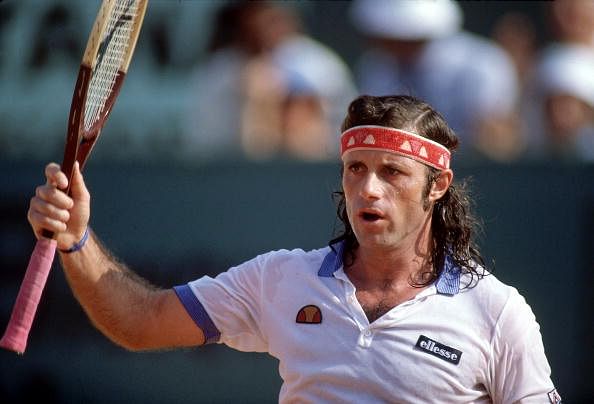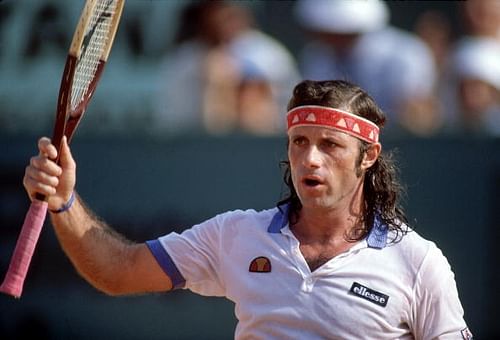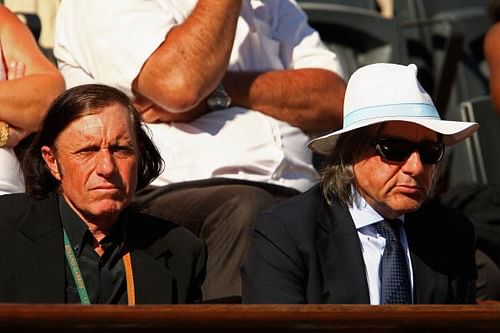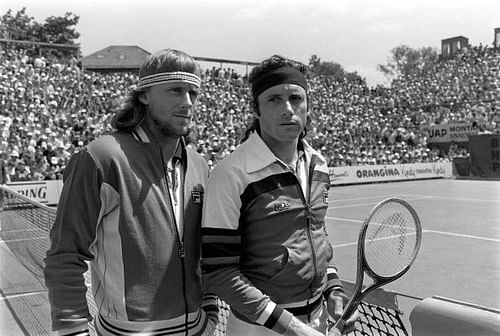
Guillermo Vilas: The king without a crown

Bull of the Pampas: Guillermo Vilas, pictured here at the 1982 US Open. (Getty Images)
Long before the reign of the ruthless Rafael Nadal, there was another left hander who stole a million hearts with his flowing mane and a game to match. The young man was heralded as the “Bull of the Pampas.” Fans swooned over him as if he belonged on a stage with Reggae artist Bob Marley. With the French Open around the corner, it is in the fitness of things to remember the man whose accomplishments provide context to those of the reigning king of clay.
Over thirty five seasons ago elated fans paraded Guillermo Vilas on their shoulders, moments after he had dealt a bagel in the fourth set to defeat Jimmy Connors 2–6, 6–3, 7–6, 6–0. In the last US Open held at the West Side Tennis Club in Forest Hills in 1977, Americans found it fit to celebrate the defeat of their own. The southpaw surprised Connors on that epochal day by making frequent forays to the net to clinch victory with a brilliant stratagem. The crowds erupted in joy with spontaneity and affection that transcended national pride and embraced the forthright Argentine. Vilas had an uncanny ability to evoke passion by indulging the fans in his brilliance.
Vilas’ memorable victory at the US Open came during a spell of immense success. The Argentine won 17 titles in 33 tournaments during the year, including his only French Open title. Nearly 29 years later, Nadal emulated Vilas’ mark of 53 consecutive match victories on clay. The Mallorcan defeated Roger Federer 6–7 (0), 7–6 (5), 6–4, 2–6, 7–6 (5) in the sensational final of the 2006 Rome Masters to match the feat. Nadal extended the streak to an incredible 81 matches, before Federer finally intervened in Hamburg 2007.
But then, as Vilas himself reminded, he established the mark in a single season. But for the controversial spaghetti string racket Vilas may have gone on to win as many as 82 matches in a row. Even as he seemed destined to extend his run, Vilas was tripped up under unusual circumstances. Ilie N?stase bothered Vilas with spin and variable bounce, aided by a specially strung racket, in the finals of the Aix-en-Provence tournament in October that year.
The Argentine resisted with spirit but struggled to find any rhythm. N?stase took advantage of heavy spin and uneven bounce to clinch the first two sets – 6-1, 7-5. Peeved by the undue advantage from the racket, Vilas walked off the court in protest. The match may have been lost, but Vilas’s bold and honest response empowered the establishment. The ATP banned the spaghetti strung racket soon after the incident, vindicating the stand of Vilas. He went on to win the Australian Open in 1978 and 1979 to account for his haul of four major titles.

Friend or foe: Villas (L) and Ilie Nastase (R), pictured here in 2009, watch the action during the French Open at Roland Garros in Paris, France. (Getty Images)
Nadal’s victory in Madrid last week was his 40th clay court title and 55th overall. Vilas notched 46 clay court titles in a career haul of 62 titles. In an era when rackets were only tools to aid the expression of the artist holding it, Vilas could extract heavy spin. His guile and skill with his supple wrist and clever use of the angle on the racket head helped him tease and taunt his opponents. Vilas’ accomplishments came during an era when players spent the time between points adjusting their strings. The Argentine had a formidable forehand for attack and a reliable slice for defence. In time, Nadal is bound to surpass Vilas’s haul of titles. The numbers shall perish, but his legacy will prevail.
The materials on the racket head and the nature of strings have undergone drastic change in the past two decades, turning it into a weapon. The modern day racket strings are capable of shifting back against the ball to impart spin before sliding back into their place. Vilas’ allure is heightened by the fact that he could achieve monstrous amounts of spin with the equipment of his time. While Vilas was never as consistent as Nadal, he was always a feared opponent on the red shale of Europe and the ugly green variant in the USA. In one grand season, he accomplished more than many do in an entire career waltzing from one victory to another.
The Argentine also had to deal with the brilliance of Bjorn Borg during much of his prime. Vilas defeated Borg in the round robin phase of the 1975 Masters (year-end tournament), but had to suffer 12 straight losses after that. The pain of losing two finals at Roland Garros (1975, ’78) and the quarters at Wimbledon (1976) only accentuated the edginess, each time he confronted Borg. Unlike the rivals of today, who suffer a homogenous civility amongst themselves, the 70s was a time of upheaval. Even then Borg and Vilas were friendly rivals in a departure from the rancour between players of that era.
Typically though there were no real friends on the road. The brooding Vilas was no exception. For all his success, Vilas was a deep thinking loner, who indulged himself in philosophy and poetry. The southpaw dealt with the emptiness in life in his book Ciento Veinticinco. At least that is one thing that neither Borg nor Nadal can usurp from the Mar del Plata native. Even during his heyday, the book of poetry made Vilas more money than his time on the court. The book’s dark, brooding reflections hardly earned a mention from critics, but his adoring fans could not have cared less.

Legends: Bjorn Borg and Vilas pose before the men’s singles final at the 1978 French Open. Borg would go onto win the match. (Getty Images)
Vilas’s closest pal was Ion Tiriac, who became his coach in 1977. The contract between the two preceded the Argentine’s unmatched run of results that year (145-14). Many believe that the burly Romanian brought some much needed focus to Vilas, besides helping him improve his serve. The adventurous Romanian was also able to convince Vilas to volley more often. It was these tactics that enabled Vilas to own the tour in that grand season and upend Connors in his own lair. But the Argentine was a sought after star and beautiful women were never too far away to distract him at every turn. Besides, Vilas treated tennis as one of many callings in life. It is this streak in him that sought a life as much as it did tennis that might have prevented a larger legacy for the Argentine.
Guillermo Vilas was a pirate who invaded with success, yet could never really reign like a king. As good as Vilas was on the court, it was his introspective streak and soulful reflections on life that endeared him to his adoring fans across the world. The collection of four majors in eight finals did no justice to the brilliance of the South American. While the grand parade of 1977 all but cemented his legacy, it was his emotional honesty that left an imprint on the soul of tennis. So much so that any narration on clay court tennis would be incomplete without a chapter or two on the “Bull of the Pampas.”